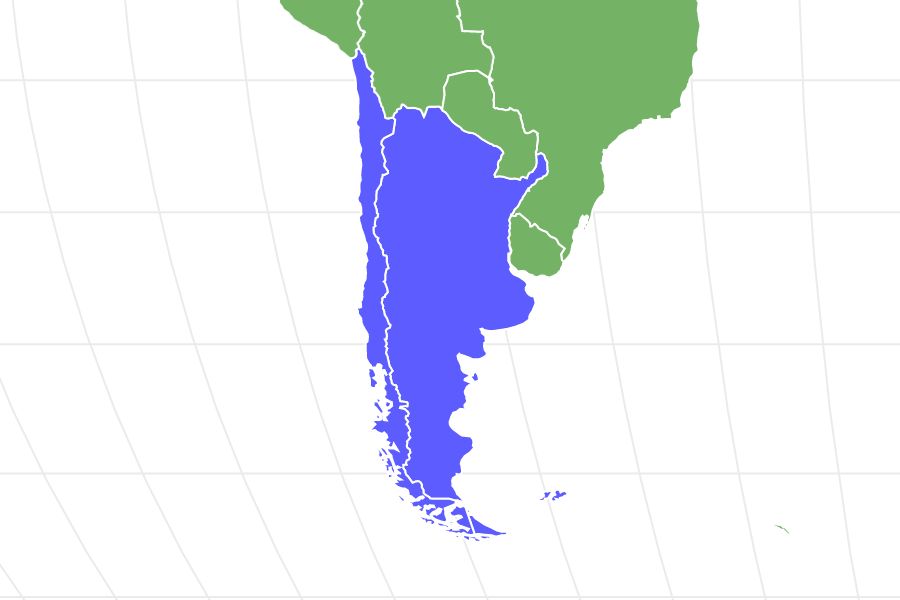Threatened by oil spills!
Advertisement
Magellanic Penguin Scientific Classification
- Kingdom
- Animalia
- Phylum
- Chordata
- Class
- Aves
- Order
- Sphenisciformes
- Family
- Spheniscidae
- Genus
- Spheniscus
- Scientific Name
- Spheniscus magellanicus
Read our Complete Guide to Classification of Animals.
Magellanic Penguin Conservation Status
Magellanic Penguin Facts
- Main Prey
- Cuttlefish, Squid, Sardines
- Distinctive Feature
- Black beak and small wings
- Habitat
- Antarctic islands
- Predators
- Sea Lion, Leopard Seal, Killer Whale
- Diet
- Carnivore
View all of the Magellanic Penguin images!
“Magellanic penguins are fast swimmers reaching speeds of 15 mph or more.”
Magellanic penguins live on both the Pacific and Atlantic coasts of South America. They are carnivorous, flightless, seabirds with a diet of small fish and crustaceans. Named for the controversial Portuguese explorer, Ferdinand Magellan, this penguin species sports a unique, all-black coat of feathers on its back – with white on its belly. The black coat makes them extremely difficult to spot from the air while their white belly is camouflaged from below by light from the sky. This evolutionary gift helps the bird to evade predators while they navigate and feed in the dark oceans. They are highly social animals that mate for life and live in groups that include as many as 400,000 penguins.
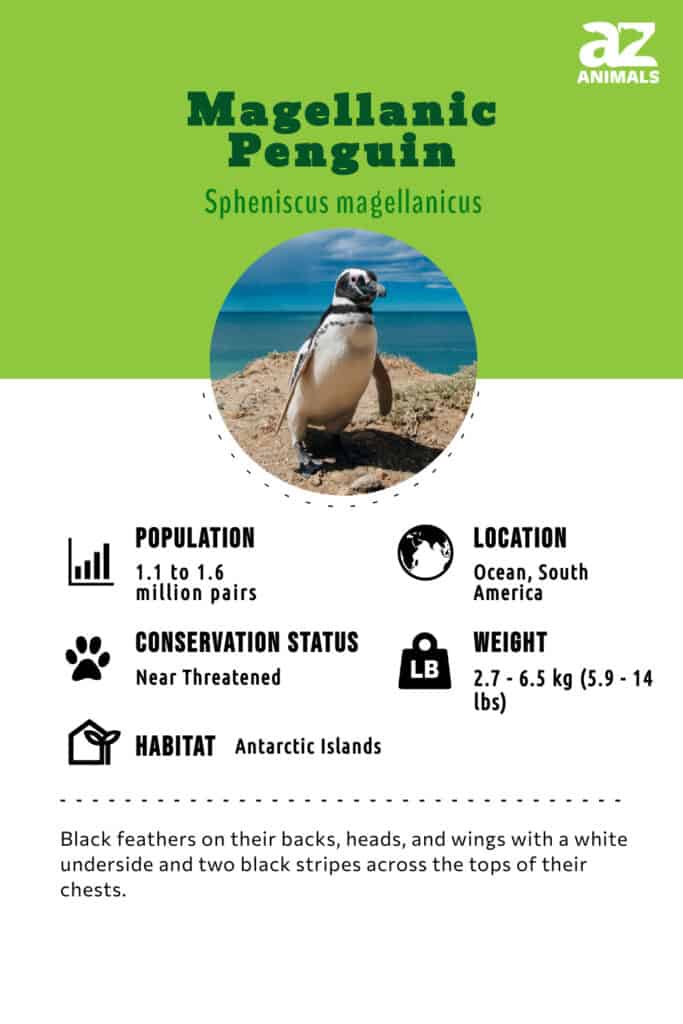
Incredible Magellanic Penguin Facts!
- They can shed feathers to cool down if they get too hot
- They eat krill, cuttlefish, and squid
- A female penguin can find her mate by listening for his specific call
- They have special glands allowing them to push out the salt they absorb from the ocean water
- The lifespan of a Magellanic penguin is 25 – 30 years
- The population of these penguins is decreasing
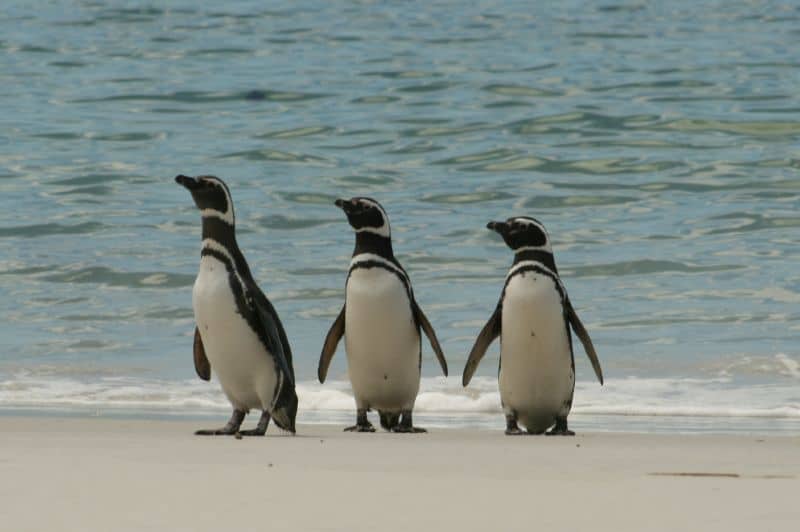
Magellanic Penguins are extremely sociable creatures.
Scientific Name and Types
The scientific name of the Magellanic penguin is Spheniscus magellanicus. Magellanicus refers to the explorer Ferdinand Magellan. He took note of these penguins as he sailed near South America in 1520. Magellanic penguins belong to the Spheniscidae family and are in the class Aves. There are no subspecies.
Evolution
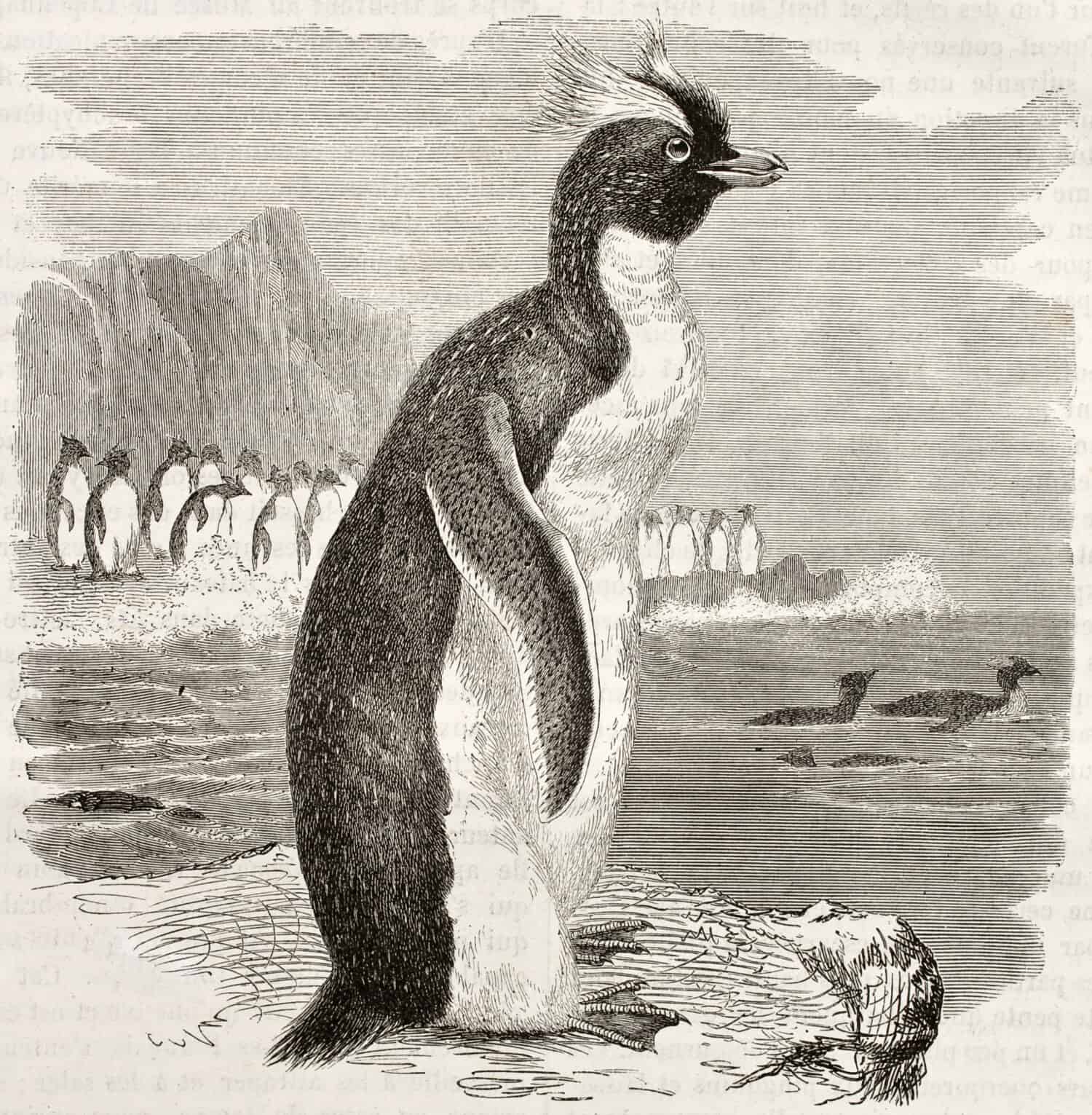
Before the days of photography, line drawings like this one from 1878 captured the penguin’s image and behavior.
Image: Marzolino, Shutterstock
©Marzolino/Shutterstock.com
Fossil records indicate that the common ancestor of all penguins lived as long as 40 million years ago and was around five feet tall. They are believed to have originated in Antarctica, which was covered in forests at the time and connected to what would become New Zealand, Australis, South America, and surrounding islands. These ancient ancestors of penguins had diverged from the ancestors of petrels and albatrosses around 71 million years ago.
The arrival of the ice age 35 million years ago brought brutal changes to the ancient ancestors of the penguin. The continents of Australia and South America drifted away from Antarctica while ocean currents encircled it. This cooling climate likely killed the older penguins – leaving them to compete with whales for the same prey.
While most of the ancient penguins became extinct, others, like the Magellanic penguin, swam to warmer waters to found new lineages. Some species, like the emperor penguin, stayed in Antarctica and evolved adaptations to living in the cold environment.
Appearance and Behavior
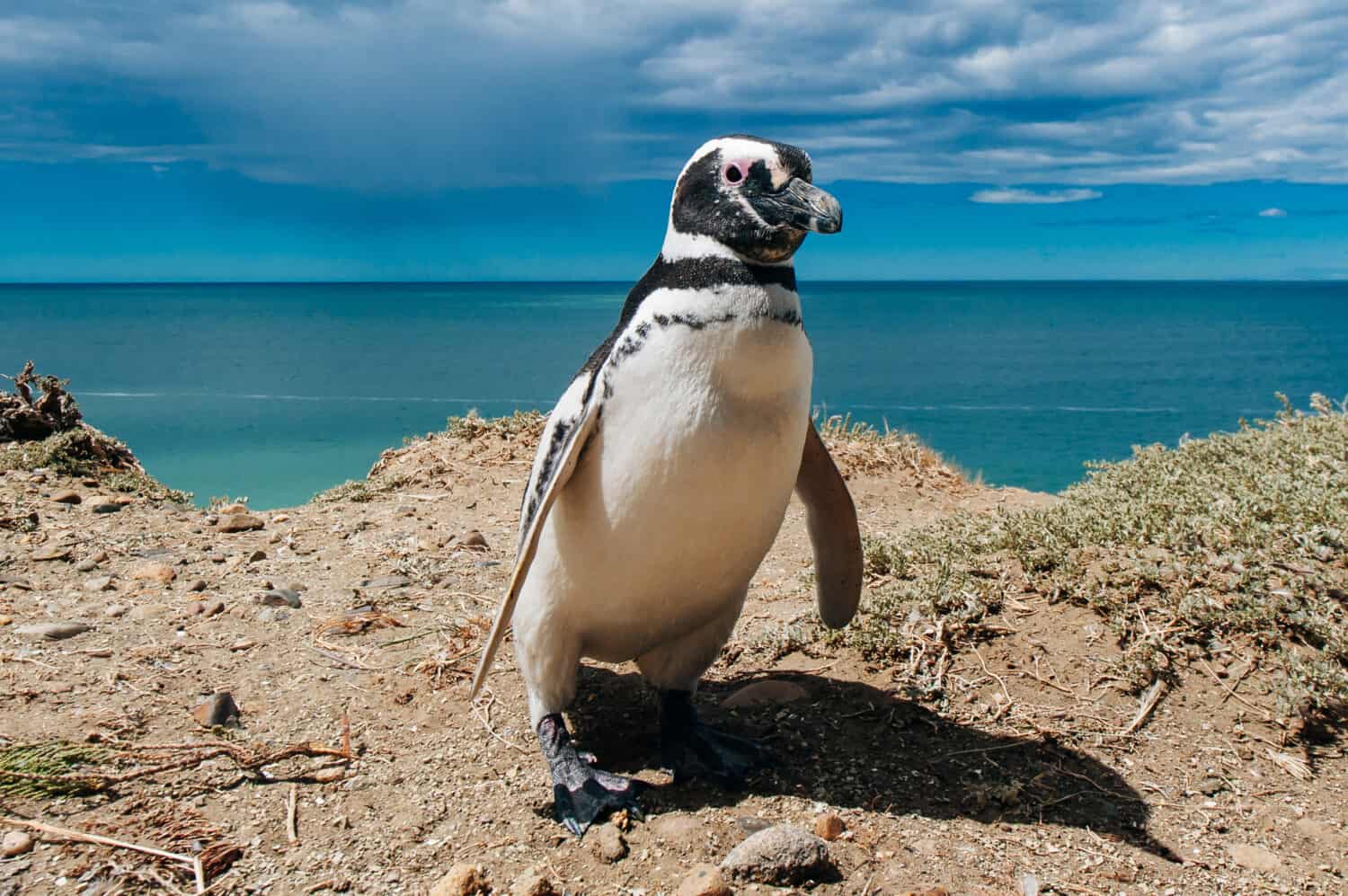
Magellanic penguins have one black stripe on their chests.
Image: Brester Irina, Shutterstock
©Brester Irina/Shutterstock.com
As mentioned earlier, Magellanic penguins have black feathers on their backs, heads, and wings. They have white feathers on their underside and two black stripes across the top of their chest. This coloration provides camouflage against predators. The Magellanic penguin can be distinguished from their close relative, the endangered African penguin which has only one black stripe on its chest. Magellanic penguins also have a ring of white running from their chin up to above their eyes.
Magellanic penguins are the largest member of the genus Spheniscus. The height range for these birds is 24 to 30 inches with a weight of 5 to 14 pounds. Males are usually larger than females. For perspective, a Magellanic penguin that’s 30 inches tall is equal in height to 2 bowling pins stacked up to make a tower. A 10-pound penguin is equal in weight to an average size housecat.

Penguins absorb a lot of salt that is released through special glands near their eyes.
Image: Ondrej Prosicky, Shutterstock
©Ondrej Prosicky/Shutterstock.com
The flippers of a Magellanic penguin as well as its slick feathers help it to swim through the water at high speed with a maximum of 15 mph. This level of speed helps them capture prey including fish and some crustaceans.
Penguins absorb a lot of salt water as they swim through the ocean. Fortunately, they have special glands located near their eyes that release salt, so they don’t have too much in their bodies.
When a Magellanic penguin gets overheated, it sheds some of its feathers to cool its body temperature. They have also been known to hold their wings out at their sides to increase air circulation. Sometimes this penguin will pant like a dog to cool off!
If humans approach a group of Magellanic penguins, these birds quickly seek shelter in their burrows. Plus, the fact that a group of penguins can number as high as 400,000 gives these birds protection from predators. There is safety in numbers!
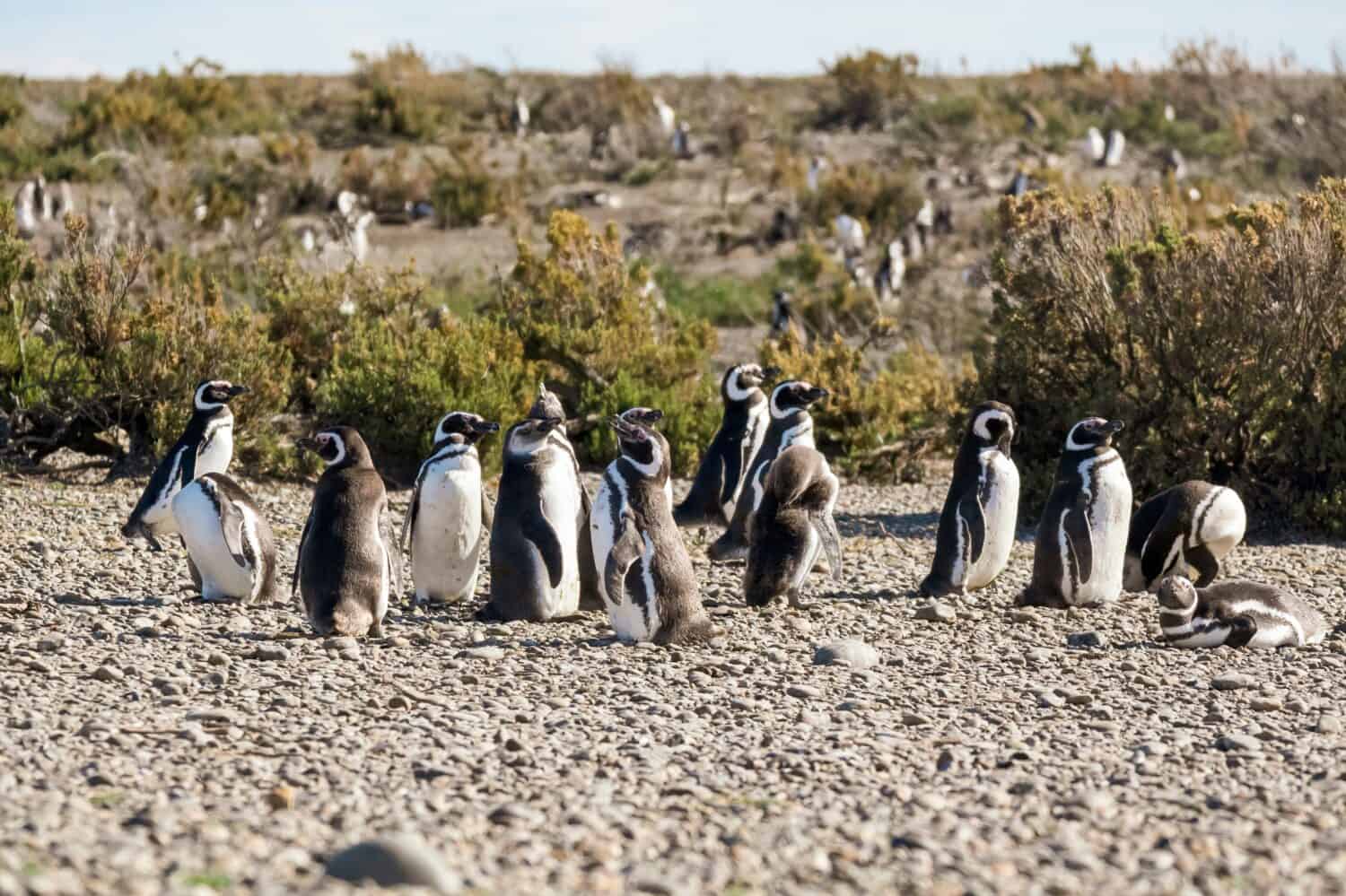
Colonies of Magellanic penguins can number in the thousands.
Image: Claudio Barrientos, Shutterstock
©Claudio Barrientos/Shutterstock.com
A Magellanic penguin’s colors help to protect it from predators while keeping them hidden from prey. A penguin’s white underside keeps them hidden from fish and other prey that cannot see them against the light filtering in from above. In addition, the black feathers on their back keep them hidden from some predators as they blend in with the dark waters of the ocean. This color combination is called countershading.
This penguin is definitely a social animal living with hundreds of thousands of other penguins in groups called colonies. Though these birds shy from humans when they come near, they are aggressive with each other. In fact, they are known to be one of the most aggressive penguins out of the many species.

The coloration of the penguin serves as camouflage to protect it from predators in the sea.
Image: Farjana.rahman, Shutterstock
©Farjana.rahman/Shutterstock.com
When breeding season begins, male penguins that have just reached sexual maturity, fight with other males causing great injury. Biting, flapping wings, and loud calls are all a part of this competition. Female Magellanic penguins fight one another over males as well.
Habitat

Argentina is one of the habitats of the Magellanic penguin.
Image: Martina Pellecchia, Shutterstock
©Martina Pellecchia/Shutterstock.com
Magellanic penguins on both the Pacific and Atlantic shores of the tip of South America. Specifically, on the coasts of Chile and Argentina as well as on the Falkland Islands. Unlike their arctic cousins, these penguins have adapted to live in a dry, temperate climate.
This species of penguin spends most of its time in the ocean waters off of South America – usually about 150 feet from shore. During the breeding season, from September to Mid-April, their habitat becomes the grassy shores of the beaches where they construct burrows or make their nests under shrubs and bushes.
After the breeding season has ended, Magellanic penguins migrate north along the South American coast to the more seasonable climates of Peru or Brazil. Thousands of Magellanic penguins can be seen swimming toward their winter post during this migration – which can involve a lengthy journey of up to 4,000 miles. Perhaps the sight of thousands of penguins swimming together is what caught the attention of Magellan and his crew!
Diet
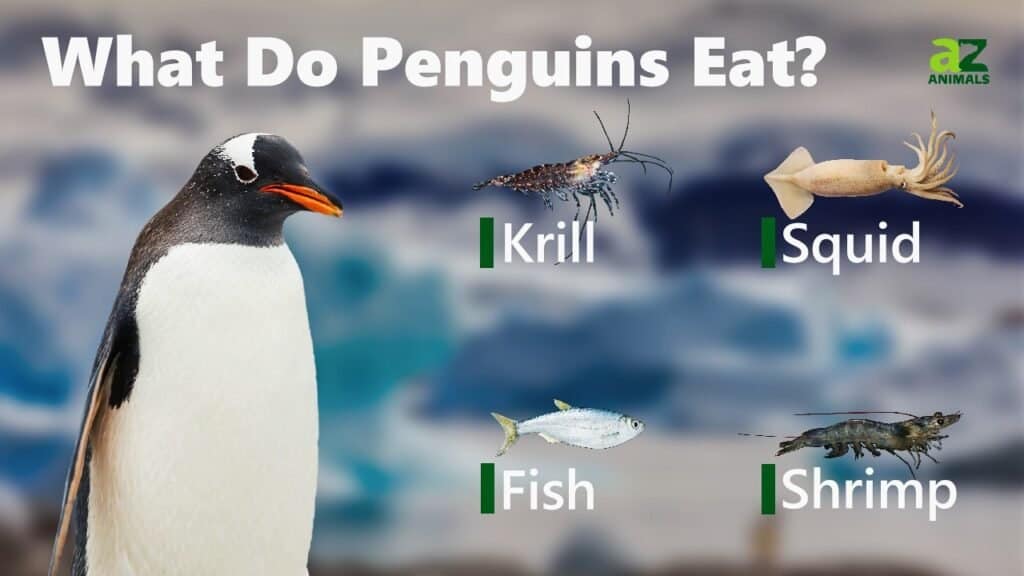
What do Magellanic penguins eat? These birds are carnivores that eat krill, cuttlefish, squid, anchovies, and sardines.
One of the most interesting facts about these particular penguins is that they dive from 100 to 200 feet into the ocean to hunt for food. Group foraging is a common practice of Magellanic penguins. Large groups of them dive together to hunt for prey and are able to capture more fish than just one penguin hunting solo.
Predators and Threats
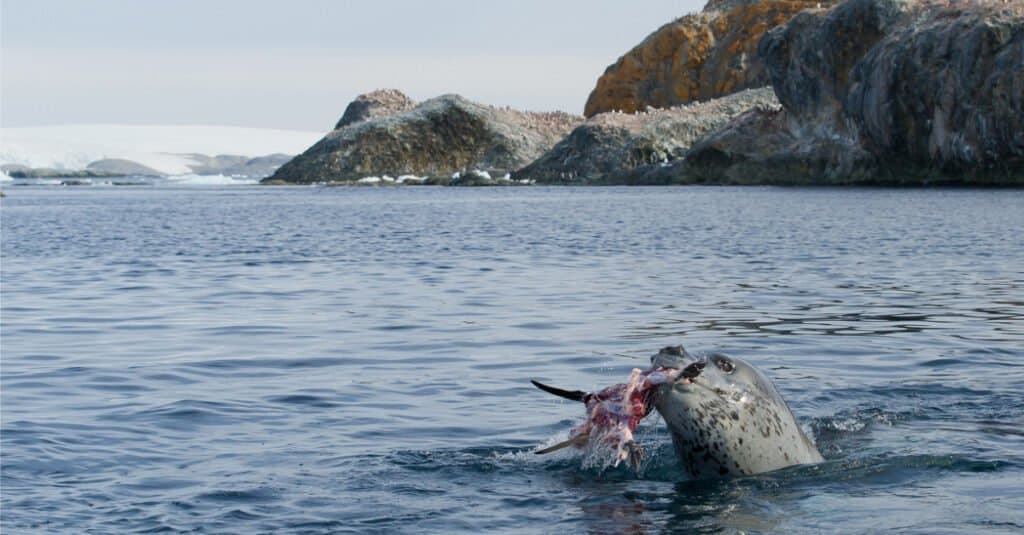
Leopard
seals prey on penguins when they are in the water,
©iStock.com/mzphoto11
Leopard seals, killer whales, and large fur seals are all predators of adult Magellanic penguins. They are captured by these predators while swimming in the ocean.
Chicks and eggs of Magellanic penguins have several predators. They’re eaten by seagulls, rats, foxes, and sometimes feral cats while still on shore.
Some other threats to these penguins include the loss of their food source. Commercial fishermen are capturing a lot of the same fish that these penguins eat. Competing with the commercial fishing industry for food has endangered the future of many types of penguins. Water pollution such as oil spills presents an environmental threat to Magellanic penguins. Flooding on these shores also puts penguin chicks and eggs in danger.
The official conservation status of these penguins is Near Threatened with a decreasing population.
Reproduction, Babies, and Lifespan

Like other penguins, Magellanics are monogamous and mate for life.
Image: Sergey Didenko, Shutterstock
©Sergey Didenko/Shutterstock.com
Like most penguins, Magellanics are monogamous. They return to the same mate every breeding season beginning in September. How can a female find her mate in a colony of hundreds of thousands of noisy, braying penguins? With keen hearing and an exceptional memory, a female penguin is able to recognize her mate through his unique call.
Hopefully, the male penguin has already scouted out their nesting site and constructed a burrow for shelter. Around October, the female penguin lays 2 eggs. The eggs have a 40-day incubation period. During that time, the male and female share the task of caring for the eggs. When one is watching over the eggs, the other bird is out in the ocean hunting for food.
The baby penguins are called chicks. They are born weighing just a few ounces and are about 3 inches long. They are covered in grayish-blue downy feathers and don’t begin to grow any waterproof feathers until they are almost one month old. These little chicks are totally dependent on their parents. The burrow serves as warm shelter and protection for penguin chicks with a light layer of feathers.

Penguin chicks are totally reliant on their doting parents.
©iStock.com/Sergdid
Penguin chicks eat the prey brought to them by their parents. One of the parents eats the prey, then regurgitates it into a chick’s mouth so the baby can digest it. As a chick grows older, it’s able to eat small pieces of torn-up fish and other prey.
Penguin chicks leave the nest when they have fledged. Fledging is when a chick grows a full collection of feathers that it will have as an adult. Penguin chicks usually leave the nest at around 4 months old.
The lifespan of a Magellanic penguin is 25 to 30 years. The record for the oldest Magellanic penguin is 36 years old.

Magellanic penguin chicks are fuzzy grey and white cuties.
Image: Rob Jansen, Shutterstock
©Rob Jansen/Shutterstock.com
Population
According to the IUCN Red List of Threatened Species, the estimated population of Magellanic penguins is 1.1 to 1.6 million pairs.
• 900,000 on the coast of Argentina
• 100,000 on the Falkland Islands
• Between 144,000 to 500,000 pairs in Chile
The conservation status of Magellanic penguins is Near Threatened and its population is decreasing.
Penguins in the Zoo

The Cincinnati Zoo features Magellanic penguins.
©Mind meal at en.wikipedia, CC BY 2.0 <https://creativecommons.org/licenses/by/2.0>, via Wikimedia Commons – License
- See a collection of Magellanic penguins at the Potter Park Zoo
- The Cincinnati Zoo has these penguins on proud display
- Check out the Magellanic penguins in the Tuxedo Coast exhibit at the Jacksonville Zoo and Gardens
Magellanic Penguin FAQs (Frequently Asked Questions)
Are Magellanic penguins herbivores, carnivores, or omnivores?
Magellanic penguins are carnivores eating krill, sardines, cuttlefish, and some crustaceans.
How long do Magellanic penguins live?
One of the most amazing facts about these penguins is they have a lifespan of 25 to 30 years!
How tall are Magellanic penguins?
The height of this penguin spans from 24 to 30 inches tall.
Why is the Magellanic penguin endangered?
The official conservation status of this penguin is Near Threatened. This is due to the loss of its food source to commercial fishermen. Also, these birds face environmental threats such as oil spills. Flooding of their habitat is another threat to the eggs and chicks of Magellanic penguins.
How long can a Magellanic penguin stay under water?
Magellanic penguins can stay underwater for about 90 seconds. You see they have to be fast swimmers so they can dive 100 or more feet into the ocean, capture their prey, and be back at the surface in 90 seconds!
What Kingdom do Magellanic Penguins belong to?
Magellanic Penguins belong to the Kingdom Animalia.
What phylum do Magellanic Penguins belong to?
Magellanic Penguins belong to the phylum Chordata.
What class do Magellanic Penguins belong to?
Magellanic Penguins belong to the class Aves.
What family do Magellanic Penguins belong to?
Magellanic Penguins belong to the family Spheniscidae.
What order do Magellanic Penguins belong to?
Magellanic Penguins belong to the order Sphenisciformes.
What genus do Magellanic Penguins belong to?
Magellanic Penguins belong to the genus Spheniscus.
What type of covering do Magellanic Penguins have?
Magellanic Penguins are covered in Feathers.
In what type of habitat do Magellanic Penguins live?
Magellanic Penguins live in antarctic islands.
What is the main prey for Magellanic Penguins?
Magellanic Penguins prey on cuttlefish, squid, and sardines.
What are some predators of Magellanic Penguins?
Predators of Magellanic Penguins include sea lions, leopard seals, and killer whales.
What are some distinguishing features of Magellanic Penguins?
Magellanic Penguins have black beaks and small wings.
How many babies do Magellanic Penguins have?
The average number of babies a Magellanic Penguin has is 2.
What is an interesting fact about Magellanic Penguins?
Magellanic Penguins are threatened by oil spills!
What is the scientific name for the Magellanic Penguin?
The scientific name for the Magellanic Penguin is Spheniscus magellanicus.
How fast is a Magellanic Penguin?
A Magellanic Penguin can travel at speeds of up to 22 miles per hour.
How do Magellanic Penguins have babies?
Magellanic Penguins lay eggs.
Thank you for reading! Have some feedback for us? Contact the AZ Animals editorial team.
Sources
- David Burnie, Dorling Kindersley (2011) Animal, The Definitive Visual Guide To The World's Wildlife
- Tom Jackson, Lorenz Books (2007) The World Encyclopedia Of Animals
- David Burnie, Kingfisher (2011) The Kingfisher Animal Encyclopedia
- Richard Mackay, University of California Press (2009) The Atlas Of Endangered Species
- David Burnie, Dorling Kindersley (2008) Illustrated Encyclopedia Of Animals
- Dorling Kindersley (2006) Dorling Kindersley Encyclopedia Of Animals
- Christopher Perrins, Oxford University Press (2009) The Encyclopedia Of Birds
- Oceanwide Expeditions, Available here: https://oceanwide-expeditions.com/to-do/wildlife/magellanic-penguin
- Aquarium of the Pacific, Available here: https://www.aquariumofpacific.org/exhibits/penguin_habitat/magellanic_penguins
- Penguin World, Available here: https://www.penguinworld.com/types/magellanic.html

